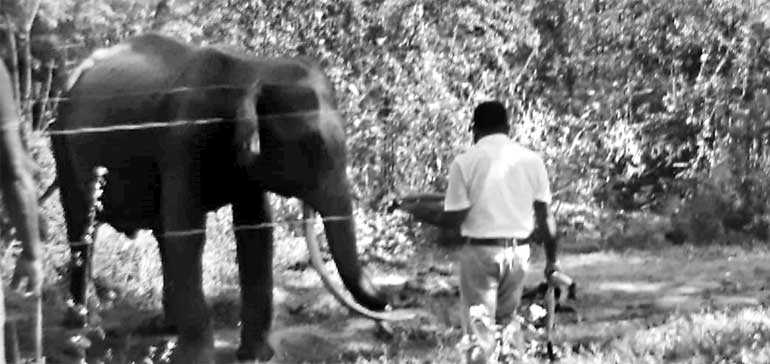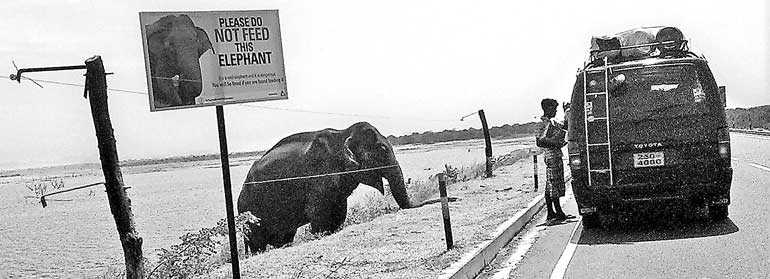Sunday Dec 14, 2025
Sunday Dec 14, 2025
Saturday, 12 January 2019 00:00 - - {{hitsCtrl.values.hits}}

A newcomer to the fence

Feeding happens right by the notice
There is possibly no other wild elephant who is more famous in Sri Lanka than Rambo of Uda Walawe National Park (UNWP). For the past two decades, Rambo has patrolled the stretch of the UNWP bund, and he has now become a permanent fixture there.
Many passing vehicles stop and feed him with juicy ‘titbits’ such as watermelon, bananas and sugar cane. He has always respected to the electric fence, and never tried break out. (The fence is really a psychological barrier because a full grown elephant can easily knock over the fence, especially during day time when there is no electric current powering the fence)
While this is quite a unique and intriguing sight, which attracts a lot of attention, it is a phenomena fraught with danger. Rambo, although seemingly docile, is a wild elephant, and if he were to break through the fence, it would result in some great disaster with dangerous consequences.
Many attempts have been made by the Department of Wildlife Conservation (DWC) to chase Rambo away with no success. The efforts came too late. Elephants are very intelligent animals and learn behaviours quickly. So any such new ‘initiatives’ have to be nipped in the bud.
Hence some form of ‘uneasy equilibrium’ has now been established, with Rambo behind the fence, and with passers-by still feeding him.
Newcomer to UWNP electric fence
Of late it has been noticed that another young male elephant with tusks has started frequenting the electric fence perimeter near the causeway and that passers-by are already beginning to feed it.
This young tusker is called Bullet and has rather unique elongated tusks. Tuskers are very rare among Sri Lankan elephant species and therefore they are very precious and should be protected at all costs.
The dangers
It was only recently that another young tusker of the UWNP was shot and killed within the confines of the park. Although there was some attention drawn to this, no follow up action seems to have been taken by the DWC or the law enforcing authorities to bring the culprits to book.
This practice of feeding wild elephants is now quite widespread and not confined to the vicinity of wild life parks only. It is very prevalent in the Deep South and areas of the North Central Province
While the grim Human Elephant Conflict (HEC) takes its toll with some 279 wild elephants dying in 2018, (that’s more than five deaths per week!) it is even more alarming that this tusker was apparently killed inside the Wildlife Park.
So there is grave and serious concern that if this young tusker gets too acclimatised to humans due to feeding, he could be lured and killed for his tusks
Therefore there is an urgent need for the authorities to take some immediate action to stop this elephant from getting used to coming to the wire fence and begging for food.
The culprits are not only Sri Lankans, but also misguided tourists who are encouraged to do so by guides.
Some simple, cohesive and sustained actions are all that is required to mitigate this problem and it should involve all stakeholders and not only the state authorities.
Sustaining the effort is of utmost importance. Many good initiatives fall by the way side because the state authorities do not persist with the initiative after the initial effort and euphoria
A case in point was when the DWC wanted such signage displayed at UWNP some years ago. I obtained sponsorship from LTL Holdings and got 12 such signs done. With a lot of fanfare these boards were erected, but there was very poor follow up ‘policing’ by the DWC. Today the elephants are fed right by the side of the warning sign!
Suggested actions
Pix by Srilal Miththapala